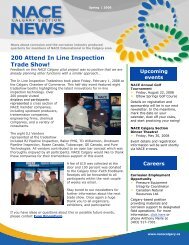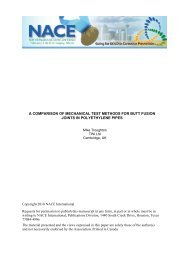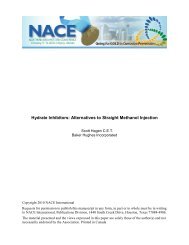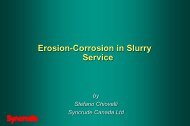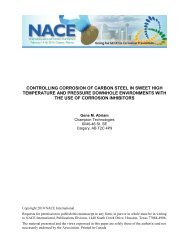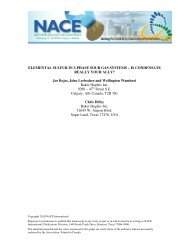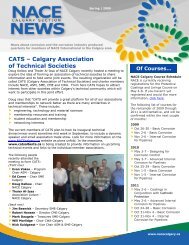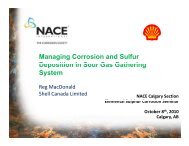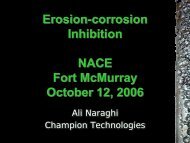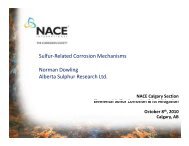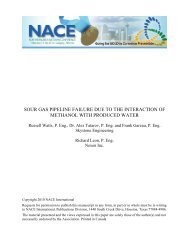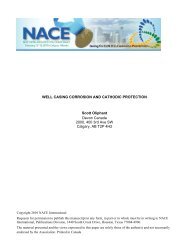Part 1: Examples and questions - NACE Calgary
Part 1: Examples and questions - NACE Calgary
Part 1: Examples and questions - NACE Calgary
Create successful ePaper yourself
Turn your PDF publications into a flip-book with our unique Google optimized e-Paper software.
<strong>Examples</strong> & Questions<br />
<strong>Part</strong> 1: <strong>Examples</strong> <strong>and</strong> <strong>questions</strong><br />
How should the decision on the application of<br />
the St<strong>and</strong>ard be made?<br />
Who is responsible for this decision?<br />
Who is responsible for the suitability of the<br />
material for the service conditions?<br />
What responsibility does the equipment<br />
manufacturer have in the material selection<br />
process?<br />
Is it sufficient to order equipment: “To <strong>NACE</strong>”?
Bullet 1: Evaluate the expected (or actual) service environment (See Clause 6).<br />
Consider if any of the permitted exclusions allow equipment that does not comply with the st<strong>and</strong>ard to be<br />
used (See Table 1).<br />
Consider if the use of any permitted exclusion is appropriate in terms of the risks of the local application.<br />
All the above are the responsibility of the equipment user (See Clause 5).<br />
Bullet 2:<br />
Bullet 3:<br />
Bullet 4:<br />
The equipment user, though he/she may enlist the help of the equipment supplier in the materials selection<br />
process (See Clause 5).<br />
The equipment supplier is responsible for compliance with the metallurgical requirements set out in the<br />
St<strong>and</strong>ard.<br />
No. The equipment user has to have a much greater involvement than in the past because of the different<br />
environmental limits for crack resistance that are now considered to apply in particular for CRAs. The<br />
equipment supplier, equipment manufacturer or materials manufacturer will require information on the<br />
materials to use or on the environmental conditions of the intended service. (See Clause 5.)
<strong>Part</strong> 2: <strong>Examples</strong> & Questions<br />
Facilities Piping<br />
Example 1:<br />
• A gas pipeline off of a separator has the following<br />
conditions:<br />
20 ° C (68°F), 4 KPa CO 2 & 1 KPa H 2 S<br />
• It is a short run of pipe <strong>and</strong> the only material available<br />
has a base material hardness of 270 HV10.<br />
• Is this acceptable?<br />
• Can we put in a Teflon liner <strong>and</strong> avoid the hardness<br />
issue?<br />
• The pipe has been cold bent to fit between the flanges.<br />
Any issues here?<br />
• A contractor has warned us that this pipe needs HIC<br />
testing <strong>and</strong> should have had a special chemistry. Is this<br />
correct?<br />
• What if the material has to be welded? Is this a show<br />
stopper?<br />
<strong>NACE</strong> International 109
Bullet 1:<br />
Bullet 2/3:<br />
1 kPa is greater than the sour service threshold for carbon <strong>and</strong> low alloy steels <strong>and</strong><br />
therefore cracking resistant materials will be needed.<br />
In terms of Option 1 this material is too hard <strong>and</strong> is not acceptable (270 HV10 is equivalent<br />
to about 27 HRC; the limit for parent materials in sour service is normally 22 HRC).<br />
In terms of Option 2 it might be possible to qualify this material for this low level of H 2 S<br />
but given the apparent time pressure this is not really an option.<br />
Bullet 4:<br />
Bullet 5:<br />
Bullet 6:<br />
Bullet 7:<br />
No, coatings or liners are not acceptable methods to guard against sour service cracking.<br />
See A.2.1.5.<br />
There may be a problem with the effects of cold bending. See A.2.1.6.<br />
Maybe; if the pipe is seamless HIC is very unlikely <strong>and</strong> testing would not normally be done,<br />
if the pipe in longitudinally welded from carbon steel plate then HIC damage is much more<br />
likely <strong>and</strong> testing must be considered. See Clause 8<br />
In this the material described is already too hard for unlimited sour service. Weld hardness<br />
must always be considered <strong>and</strong> must be kept below 250 HV10. See 7.3.3, A.2.1.4 <strong>and</strong> Table A.1.
<strong>Part</strong> 2: <strong>Examples</strong> & Questions<br />
Casing Design<br />
A gas well with condensed water with a pH of 3.5 <strong>and</strong><br />
PP H2S of 3 psi has these casing requirements:<br />
• Production liner with a minimum temperature of 65°C<br />
(150 o F) requires 105 ksi YS to resist burst failure.<br />
What are acceptable casing grades?<br />
• Can C-110 SS be used as a tie back to the surface at<br />
4.5°C (40 o F) mudline temperature?<br />
• If the casing can be set at 107°C (225 o F), can Q-125<br />
be used?<br />
Chemistry restrictions for purchase?<br />
<strong>NACE</strong> International 110
Bullet 1:<br />
Bullet 2:<br />
Grades with sufficient yield strength that meet the requirements of Table A.3,<br />
Column 2 including A.2.2.3.2.<br />
No. C-110 is not considered suitable for the sour service conditions defined in this case,<br />
see Table A.3.<br />
However, if the conditions are less severe, e.g. the conditions of pH <strong>and</strong> H 2 S partial pressure<br />
in Region 1 of Fig. 1, it can be possible using Option 2 to qualify C-110 for use at the mudline temperature.<br />
Bullet 3: Yes. Q-125 can be used above 107°C (225 °F) subject to Table A.3 Footnote b.
<strong>Part</strong> 3: <strong>Examples</strong> & Questions<br />
Example 1<br />
• 316 SS piping is suggested for a mixed phase oil<br />
stream downstream of a choke <strong>and</strong> going to a gas<br />
separator. Is this alloy acceptable?<br />
Conditions of service 54°C (130°F), 14 psi H 2 S,<br />
<strong>and</strong> 3.5 pH for oil !??<br />
• Gas off a separator has 25 psi H 2 S? Is there a<br />
problem with using 316 SS piping?<br />
• There are 316 SS KO drums in between<br />
compressor stages in a sour gas system. Are<br />
these acceptable?
Bullet 1:<br />
Yes, Table A.1 refers to Table A.2 for "Any equipment or component". Table A.2 shows 316 to be<br />
acceptable up to 60°C (140°F) with 15 psi of H 2 S. There are no limits placed on pH or chloride<br />
concentration.<br />
Bullet 2: Assuming water separation is effective <strong>and</strong> less than 50 ppm chloride is achieved in the water phase, 316<br />
can be used with unlimited H 2 S at any temperature or pH. (See Table A.2.)<br />
Bullet 3:<br />
Yes, Table A.1 refers to Table A.6 for compressors <strong>and</strong> this Table sets no environmental limits for 316 SS<br />
used in compressors.<br />
Table A.4 also allows 316 SS for instrument tubing.
<strong>Part</strong> 3: Example 2 - Completing<br />
a gas production well<br />
We wish to choose the 80 ksi min. YS<br />
tubing <strong>and</strong> packer for a gas well.<br />
• Service conditions:<br />
10,000 psi BHP<br />
120°C (250 o F) BHT<br />
10,000 ppm chlorides<br />
No elemental sulfur<br />
5% H2S<br />
What steps are necessary to enable a suitable<br />
choice of materials?
Step 1:<br />
Step 2:<br />
Step 3:<br />
Step 4:<br />
Calculate the partial pressure of H 2 S (See <strong>Part</strong> 2, Annex C).<br />
10,000 psi x 5% = 500 psi H 2 S (3,500 kPa)<br />
Assume that the use of a CRA is necessary for such extremely corrosive conditions.<br />
Consult <strong>Part</strong> 3, Table A.1; under “Downhole tubular components” reference is made to Tables A.19 <strong>and</strong><br />
A.25 for high strength CRA tubing alloys. Note: Use can also be made of nickel based alloys that appear in<br />
Table A.14 under “Any equipment or component” for tubing applications<br />
Consider c<strong>and</strong>idate materials:<br />
Materials listed in Table A.19 are limited to 10 kPa (1.5 psi)<br />
The super duplex stainless steels listed in Table A.25 are limited to 20 kPa (3 psi)<br />
The cold-worked Ni base alloys, types 4c, 4d <strong>and</strong> 4e (See Table A.12 <strong>and</strong> Annex D, Table D.3) are<br />
acceptable for BHT of 120°C (250°F) (See Table A.14)<br />
Step 5:<br />
For packers <strong>and</strong> other downhole accessories:<br />
Many of the precipitate hardened alloys listed in Tables 31, 32 <strong>and</strong> 33 are suitable for use under the design<br />
conditions for this well. Alloys 718 <strong>and</strong> 925 are capable of being heat treated in thick sections <strong>and</strong> are<br />
regularly used for these components.



